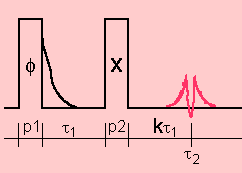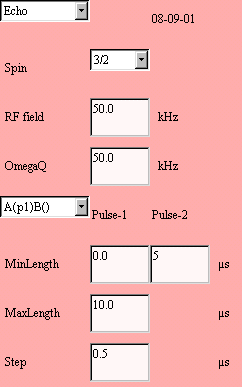AIM: Determination of the quadrupole coupling from a featureless NMR lineshape
Launch the MQMAS applet with Java Web Start.

The multi-quantum magic angle spinning (MQMAS) experiment on half-integer quadrupole spins was introduced by L. Frydman and co-workers. In the basic two-pulse sequence, it is an echo experiment involving transitions between non-consecutive energy levels during the excitation of the spin system by the first pulse. The MQ coherences generated by this pulse are converted back to -1Q coherence as an echo and an anti-echo by the second pulse. Mainly the central-transition signal is detected. The observation of the echo and anti-echo requires the optimization of the two pulse-lengths p1 and p2.

The echo and the anti-echo amplitudes in this experiment are a product of two functions: the MQ excitation function A(p1) that depends on p1 and the conversion function B(p2) that depends on p2.
The left part of the simulation panel indicates the physical parameters. It is preset for a typical experiment on a spin I = 3/2. You can introduce your own values.
First, we select either the echo signal or the anti-echo signal with the choice box.
Then, with the lower choice box we select one of the four
types of calculation available:
(1) A(p1)B(): the echo amplitude with p1 variable and
p2 constant;
(2) A()B(p2): the echo amplitude with p1 constant and
p2 variable;
(3) B(p2): the conversion function;
(4) A(p1): the MQ excitation function.
When a pulse length is constant, it should be provided in the MinLength field.
MinLength: the first variable pulse-length in µs
MaxLength: the last variable pulse-length in µs
Step: the increment of the variable pulse-length in µs
Finally, we select the MQ coherence generated by the first pulse, shown in the text-area above the RUN button.
The following applet is initialized for the -3QMAS echo amplitude A(p1)B() of a spin I = 3/2 in a single crystal; the pulse length p2 is equal to 5 µs and p1 increases from 0 to 10 µs by 0.5 µs step. The experimental line intensities are identical to the simulated ones.
Help for selecting all the simulated data of the line intensity text area in a JDK1.1.8 applet.
